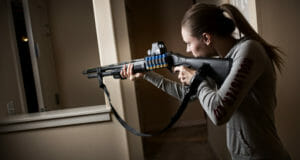An oft-forgotten segment of most range shooters’ training is the tactical reload. That’s usually due to the range environment, which discourages anything that looks like rapid movement on the part of the shooter. Most range shooters will, after realizing that their magazines are empty, calmly put the weapon on safe and eject the magazine in a most leisurely fashion. Furthermore, said shooters will, when finally ready, reach down onto the bench rest or table and grab a fresh magazine, placing it into the weapon at their convenience.
It’s no secret that range shooting develops these sorts of casual habits. No one wants to make sudden movements or look like Rambo on the firing line. This caution really stifles learning how to properly – and quickly – load your weapon.
The Tactical Reload
As with most everything on a handgun, there is a very good reason why certain features are designed just the way they are. One of them is the magazine release button. You probably already know that when you push the mag release, the magazine (loaded or empty) drops clear of the weapon and falls away. Gravity does all the work here. Push the button, and the mag is gone. Except you never use it in this manner on a range! Most shooters will push the mag release and carefully extract the magazine with their other hand, catching the falling magazine so they can put it on the bench rest. This presents a problem for the tactical shooter. Muscle memory is everything. Magazines, simply put, are designed to be ejected from the weapon and fall to the floor, plain and simple. But you’d never let them fall to the floor on a range, primarily because the magazines could bounce over the firing line, making them irretrievable, or you might be scolded by one of the range staff for appearing to be careless and dropping equipment.
So what’s the big deal on dropping mags, anyways? Why is it so important to learn to shoot in this manner? As previously stated, there is a reason for everything on a firearm. Dropping mags free of the pistol serves a very important purpose! To illustrate what this purpose would be, try this at home:
- Take a SAFE handgun with no ammo in it (or near you).
- Load an EMPTY magazine in the handgun.
- Point the handgun at a safe target. Look at the sights.
- Now drop the mag like at the range. This usually means you twist it slightly, push the mag release, and bring your other hand up to grab the falling mag.
- As you drop the mag, look at the sights….you are most likely not on target!
- Now try dropping the mag and letting it fall while keeping the gun on the target.
So this is one of those “aha” moments – the reason you drop the magazine and let it fall to the ground is so you can keep the gun on target! It has nothing to do with babying the magazines (they can take it). The conclusion here is that shooting ranges have inadvertently taught a slew of shooters to improperly change magazines simply to cater to range etiquette instead of allowing the proper tactical reload. The importance of this cannot be overstated!
So how do we go about doing the proper tactical reload in that case? Simple. Next time you’re somewhere where it’s safe and legal to do so, try this:
- Keeping the weapon on target, fire off a full magazine.
- When the slide pops back and the gun is empty, continue to keep the weapon on target. Realize that an assailant who is head on will not be able to discern that the slide of the weapon is in the rear position by looking at the weapon from the front. Keep your tactical advantage. Keep the empty gun pointed at the target.
- Release the magazine. Let it fall, and forget about it.
- Grab a fresh magazine as the old one is falling. Don’t teach yourself to grab it off a bench or table, grab a fresh mag from a magazine holder! Practice where you will store the magazine on your person, and draw it from there. You will need much practice in this regard because if you’re used to having your magazines neatly arranged on a table, you’ll probably draw them backwards the first few times.
- Drive the new magazine home and release the slide stop. Your weapon is now in battery.
- Your sights should have remained on the target the whole time!
The tactical reload is a simple and effective procedure that requires far less motion and coordination than the standard range reload you’ve been performing all these years, and it’s the right way to reload a weapon. Keep in mind that your firearm was meant to be reloaded in this manner, and a normal range reload is a corruption of this task. Practice this often – it might just save your life.
 Off The Grid News Better Ideas For Off The Grid Living
Off The Grid News Better Ideas For Off The Grid Living




